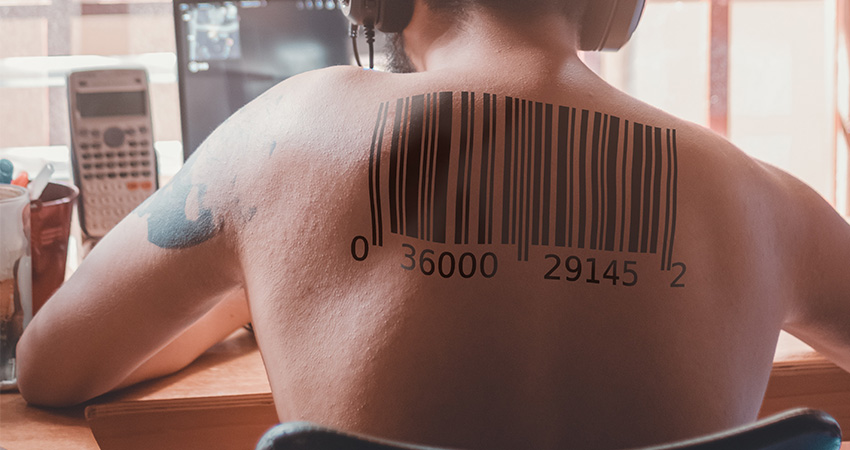Barcodes generally don’t work as body art (credit: José León on Unsplash)
Barcodes have been completing transactions and making inventory organization a breeze since the 1970s.
A little over 50 years ago (March 31, 1971), leaders from the biggest names in commerce came together and transformed the global economy forever by developing the Global Trade Item Number (GTIN). This numerical code uniquely identifies every single product and is the core of the barcode, the most important supply chain standard in history. Today, the barcode is scanned over six billion times every day and remains one of the most trusted symbols in the world.
History of The Barcode
Before the barcode was introduced, managing inventory from label to self to checkout was time consuming and manual. Not only was this process inefficient, but there was also plenty of room for human error.
The origin story of the barcode starts in Philadelphia at a grocery store. Its manager had become so frustrated with the slow checkout process that he contacted a dean at Drexel Institute of Technology in Philadelphia, desperate for a solution. Bernard Silver, a graduate student at the time, had overheard the conversation and relayed the information to Joe Woodland, another Drexel grad student and established inventor, who was immediately captivated.
Woodland was so intrigued by solving this pervasive retail problem that he pressed pause on grad studies and relocated to Miami to work on a plan that would revolutionize the grocery store experience. The idea for the first barcode came as Woodland sat on the beach drawing lines in the sand, which reminded him of the dots and dashes that exist in morse code.
Woodland applied the same general idea of morse code to those sand drawings. Ultimately, he figured out that he could develop a vast number of codes by changing the line sizes through increasing or decreasing their width. He returned to Philadelphia, and with the help of Silver, the two developed a prototype system and filed a patent for the technology in 1949.
Unfortunately, the first prototype that would actually read the barcodes failed because the internal light, a 500-watt incandescent lightbulb, was not bright enough and the machine lacked a minicomputer that could process information. Woodland stopped working on the barcode project after running into limitations and it wasn’t picked up again until 1966 by Kroger. The chain knew it needed to become more technologically efficient in order to grow, so it began advertising for help in creating a new scanning system.
Kroger tapped the Radio Corporation of America, which used Woodland’s original bullseye-styled barcode. Initially, there were concerns that the new tech would turn off customers who might view its laser technology through a popular culture lens as being akin to death rays, a la sci-fi movies and television shows. Still, testing went forward in 1973 at a Cincinnati Kroger, and it was a certified hit. While printing the bullseye barcodes proved difficult, the outcome was exactly what supermarket managers were expecting: Higher sales and quicker shopping experiences.
The Barcode Gains Popularity
The success with the supermarket barcode was just the beginning. Soon, there was interest across other consumer industries. Some of the biggest success stories come from billion-dollar big box businesses like Walmart and Target. For those two, the barcode became essential, particularly as they grew into the behemoths they are now. The barcode allows these businesses to keep a better record of what’s available on the floor, what items are in transit to their warehouses, and even the delivery of products to consumers.
Now most restaurants feature a square-shaped, pixel-patterned QR code on your table for mobile scanning in place of a traditional menu to minimize contact. The introduction of QR codes proved that product information didn’t need to be limited to straight lines as a traditional barcode, but it could also be embedded into various sizes and shapes on a label.
Different Types of Barcodes
Barcodes and QR codes really fall under two general classes: One-dimensional (1D or linear) and two-dimensional (2D). They are used in different types of applications, and in some cases are scanned using different types of technology. The difference between 1D and 2D barcode scanning is in the layout and amount of data that can be stored in each, but both can be used effectively in a variety of automatic identification applications.
Linear or 1D barcodes, like UPC code on consumer goods, use a series of variable-width lines and spaces to encode data, which most consumers think of as “barcode.” Scanners read 1D barcodes horizontally. 1D laser barcode scanners are the most common, typically handheld, wearable or fixed form factors.
2D barcodes, like Data Matrix, QR Code or PDF417, use patterns of squares, hexagons, dots and other shapes to encode data. Because of their structure, 2D barcodes can hold more data than 1D (up to 2,000 characters), while still appearing physically smaller. The data is encoded based on both the vertical and horizontal arrangement of the pattern, thus it is read in two dimensions. These codes can also contain images, website addresses, voice, and other types of binary data.
The Future of Barcodes
While still highly prevalent, as scanner technology continues to evolve there will be less need and demand for 1D barcodes over time, which can only hold up to 85 characters. In contrast, 2D barcodes can store over 7,000 characters, allowing you to transmit almost two paragraphs of information. With 2D barcodes, businesses can convey much more complex information, like expiration dates and serial numbers, all without additional scanning.
In the immediate future, you’ll see both technologies utilized in conjunction with better scanning devices, like self-scanning tunnels that can scan an item’s code regardless of how it passes through the device. The second phase will be in “image barcodes” which will be able to scan an item based on its logo and appearance.
In the next few years, we’ll continue to see a massive convergence of smartphone technology, radio tags or packages with unseen barcodes, all designed to give consumers an unprecedented level of product information and control, anytime, anywhere.
Gabe Grifoni is founder and CEO of Rufus Labs

